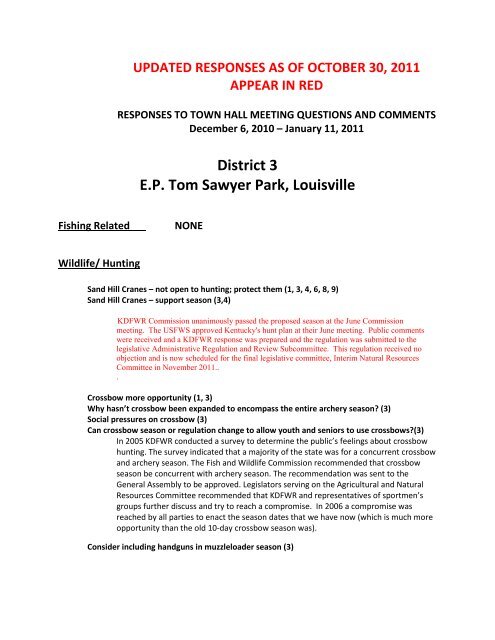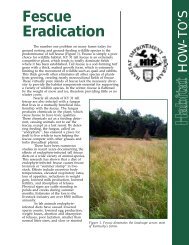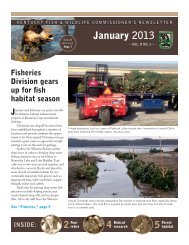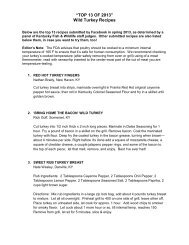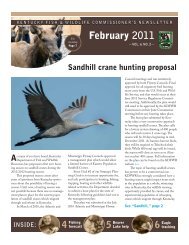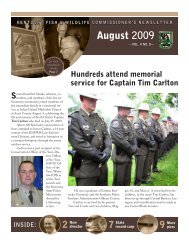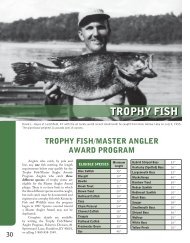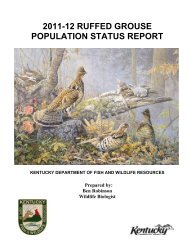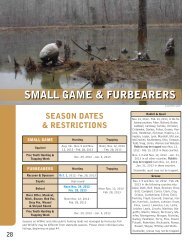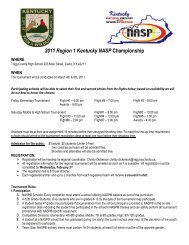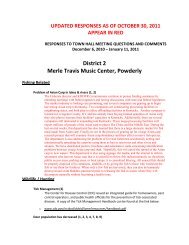District 3 E.P. Tom Sawyer Park, Louisville - Kentucky Department of ...
District 3 E.P. Tom Sawyer Park, Louisville - Kentucky Department of ...
District 3 E.P. Tom Sawyer Park, Louisville - Kentucky Department of ...
You also want an ePaper? Increase the reach of your titles
YUMPU automatically turns print PDFs into web optimized ePapers that Google loves.
UPDATED RESPONSES AS OF OCTOBER 30, 2011<br />
APPEAR IN RED<br />
RESPONSES TO TOWN HALL MEETING QUESTIONS AND COMMENTS<br />
December 6, 2010 – January 11, 2011<br />
Fishing Related NONE<br />
Wildlife/ Hunting<br />
<strong>District</strong> 3<br />
E.P. <strong>Tom</strong> <strong>Sawyer</strong> <strong>Park</strong>, <strong>Louisville</strong><br />
Sand Hill Cranes – not open to hunting; protect them (1, 3, 4, 6, 8, 9)<br />
Sand Hill Cranes – support season (3,4)<br />
KDFWR Commission unanimously passed the proposed season at the June Commission<br />
meeting. The USFWS approved <strong>Kentucky</strong>'s hunt plan at their June meeting. Public comments<br />
were received and a KDFWR response was prepared and the regulation was submitted to the<br />
legislative Administrative Regulation and Review Subcommittee. This regulation received no<br />
objection and is now scheduled for the final legislative committee, Interim Natural Resources<br />
Committee in November 2011..<br />
.<br />
Crossbow more opportunity (1, 3)<br />
Why hasn’t crossbow been expanded to encompass the entire archery season? (3)<br />
Social pressures on crossbow (3)<br />
Can crossbow season or regulation change to allow youth and seniors to use crossbows?(3)<br />
In 2005 KDFWR conducted a survey to determine the public’s feelings about crossbow<br />
hunting. The survey indicated that a majority <strong>of</strong> the state was for a concurrent crossbow<br />
and archery season. The Fish and Wildlife Commission recommended that crossbow<br />
season be concurrent with archery season. The recommendation was sent to the<br />
General Assembly to be approved. Legislators serving on the Agricultural and Natural<br />
Resources Committee recommended that KDFWR and representatives <strong>of</strong> sportmen’s<br />
groups further discuss and try to reach a compromise. In 2006 a compromise was<br />
reached by all parties to enact the season dates that we have now (which is much more<br />
opportunity than the old 10-day crossbow season was).<br />
Consider including handguns in muzzleloader season (3)
Muzzleloading handguns are included in the season. Adding any form <strong>of</strong> centerfire<br />
weapon to the muzzleloading season not only violates the spirit <strong>of</strong> having an exclusive<br />
season, it makes things more difficult for law enforcement.<br />
Deer population has decreased (1, 2, 3, 4, 7, 8, 9)<br />
Current statewide deer population trends are nearly stable to slightly decreasing. Over<br />
the past few years deer zones in many counties have been made more restrictive to try<br />
to boost the deer population. KDFWR deer biologists look at each county’s deer<br />
population trend every year. Based on that population trend a county’s zone can be<br />
changed to better manage the deer population in the county. A county’s deer zone is<br />
determined by a combination <strong>of</strong> many things. Along with the population model, deer<br />
vehicle collision numbers, crop damage complaints, and hunter satisfaction are all taken<br />
into account when determining what a county’s zone should be.<br />
Depredation tags – who gets them? How many do they get? Post who gets tags on website.<br />
Hunters could help get rid <strong>of</strong> the problem deer. (3)<br />
Landowner crop depredation tags are issued by KDFWR law enforcement <strong>of</strong>ficers and<br />
wildlife biologists. An <strong>of</strong>ficer or biologist will come to the property and assess the<br />
amount <strong>of</strong> damage. He or she will determine how many tags are needed to control the<br />
damage issue and then issue the tags to the landowner. It is then up to the landowner<br />
to decide who will harvest the deer. Each damage tag recipient must complete a<br />
shooter designation form to record who will be the one harvesting the animal. All<br />
antlers from antlered deer killed on depredation tags must be turned over to KDFWR.<br />
Staff always encourages landowners to control deer via hunter access.<br />
Change baiting laws during hunting season (3)<br />
Wild turkeys are extremely susceptible to baiting or feeding and the use <strong>of</strong> those methods for<br />
hunting purposes would undoubtedly lead to local, if not regional, overharvest in <strong>Kentucky</strong>.<br />
Therefore, the use <strong>of</strong> bait will not be considered for the take <strong>of</strong> turkeys during the spring season<br />
when harvest pressure is greatest. However, the KDFWR will examine the regulatory wording <strong>of</strong><br />
other states and evaluate the potential for including a legal distance for hunting on property where<br />
feeding <strong>of</strong> wildlife occurs in the fall.<br />
Change Turkey season dates (1, 3, 7)<br />
The spring season structure in <strong>Kentucky</strong> is established to maximize harvest opportunity while<br />
minimizing negative effects to breeding and reproductive output. Our opening day <strong>of</strong> the Saturday<br />
closest to April 15 allows exceptional harvest opportunity, but after a significant proportion <strong>of</strong><br />
hens have been bred. This strategy has produced record and near-record spring harvests since its<br />
implementation. For those desiring an earlier opening date, from 2012-2015 the spring season<br />
will open earlier, on the second Saturday in April.<br />
Change Muzzeloader season (2, 3, 7)<br />
There is simply no time or place to move or expand the muzzleloader season. Deer gun<br />
hunters have to balance hunting time in the field with small game hunters, archery<br />
hunters, waterfowl hunters, predator hunters, and elk hunters. When season lengths<br />
and dates are changed for one user group it affects another hunting user group.<br />
Although it might make sense to one user group to make a date change, such changes<br />
are negatively viewed by other user groups.
Spring Season on Turkey moving to 2 nd Saturday in April. Are we planning on doing it again?<br />
The existing spring turkey regulation defines the opening day <strong>of</strong> turkey season as the<br />
Saturday closest to April 15. As such, the season opener fluctuates between the second<br />
and third Saturday <strong>of</strong> April between years. Beginning in 2012 and lasting until 2014 the<br />
opening date for the spring turkey season in <strong>Kentucky</strong> will occur on the second Saturday<br />
in April.<br />
Concerns on decline <strong>of</strong> small game & seasons (rabbits, quail, grouse) (1, 2, 3, 4, 5, 7, 8 ,9)<br />
The <strong>Department</strong> shares the concern for decline <strong>of</strong> small game. The seasons continue to<br />
be a popular debate with overlap <strong>of</strong> deer seasons and creating a single season that ends<br />
sometime in February. KDFWR has been one <strong>of</strong> the national leaders in restoration for<br />
bobwhite (mgt will also benefit rabbits). We also continue to move towards a more<br />
active forest management program on WMAs and through private lands efforts that will<br />
benefit ruffed grouse.<br />
KDFWR is working to create a cooperative program for private land owners to support small<br />
game management practices, which will include evaluating cost-benefit <strong>of</strong> existing tactics and<br />
developing critical measures <strong>of</strong> success.<br />
What is being done for small game hunting in the 3 rd <strong>District</strong>? (3)<br />
The Sinking Creek bobwhite focal area is underway with a seasonal biologist in-place<br />
promoting private lands management. An Environmental Quality Incentives Program<br />
grassland focus area was also established here through the efforts <strong>of</strong> the <strong>Department</strong><br />
and conservation partners. Yellowbank WMA has increased activity for the<br />
management <strong>of</strong> small game habitat in the last few years. Commonwealth Chapter <strong>of</strong><br />
Quail Forever has provided outstanding support for equipment on that area as well.<br />
Quail Quota Hunt on Peabody – stop rabbit hunting the day before the quota hunt & while<br />
they are hunting. (3)<br />
This will be evaluated each year after the seasons. As <strong>of</strong> now the impact <strong>of</strong> rabbit hunting seems<br />
negligible and this format allows us to provide opportunity for both groups.<br />
1 deer a day on public land, public land hunter is being slighted. Allow same opportunities on<br />
public land and private (3)<br />
The 1 deer per day rule was requested by a Commissioner out <strong>of</strong> concern that some<br />
WMAs may be over pressured if hunters were allowed to take more than 1 deer per<br />
day.<br />
Youth Involvement ( 1, 2, 3, 4, 5, 6, 7, 8, 9)<br />
Change youth season (2, 4, 7, 9)<br />
In October – November when temperatures are milder (2)<br />
2 days is not enough! Needs to be longer.(4)<br />
No change to youth seasons is currently recommended. Current youth seasons are the best<br />
compromise at this point.<br />
1,000 Elk tags were too many (3)<br />
Based on statistical models and ground counts <strong>of</strong> elk, the population is sufficient to<br />
handle this level <strong>of</strong> harvest without decreasing the overall herd. The low natural
mortality rate and high calving rate allows us to harvest at this level and still maintain a<br />
healthy population.<br />
Law Enforcement Related<br />
Get a raise and get them some help/Need a game warden in our county<br />
Budgetary restraints make it difficult to give raises even though we all know that they<br />
deserve them. The Division is in the process <strong>of</strong> identifying the next group <strong>of</strong> counties to<br />
be hired for conservation <strong>of</strong>ficer.<br />
Other<br />
Upland Bird License<br />
KDFWR has already a “Conservation Permit” provided for in regulation 301 KAR 3:022,<br />
which at a cost <strong>of</strong> $10 annually, could be defined for use as a “birding license” or other<br />
wildlife-watcher permit. Currently this permit remains inactive. The department is<br />
aware that some states <strong>of</strong>fer similar permits or “habitat stamps” that establish a userpay<br />
system for more non-traditional participants in fish and wildlife related activities.<br />
KDFWR plans to look more formally at these opportunities as part <strong>of</strong> our planned priceelasticity<br />
study in 2011.<br />
Decline in License Sales? Are youth and landowners counted?<br />
In <strong>Kentucky</strong>, youth under the age <strong>of</strong> 12 are not required to purchase a hunting license;<br />
whereas youth under the age <strong>of</strong> 16 are not required to purchase a fishing license. Also,<br />
landowners in <strong>Kentucky</strong>, along with their “dependents” and “tenants” are not required<br />
to purchase either hunting or fishing licenses if they hunt or fish on their specific<br />
property. See KRS 150.170. Because each <strong>of</strong> these groups is license “exempt”, there is<br />
no method to determine an accurate count <strong>of</strong> youth or landowners, except to say that<br />
they are not included in the license sales data. (Note: Some youth and landowners,<br />
even though they are not required, may still purchase hunting and fishing licenses and<br />
therefore would be counted in the license sales data should they do so.)<br />
Fees on Otter Creek—Discounts<br />
The Otter Creek Outdoor Recreational Area is now open and <strong>of</strong>fers a variety <strong>of</strong> outdoor activities.<br />
There are no special discounts at this time; however, KDFWR intends to evaluate our usage and<br />
sales data in 2012 (after our first year <strong>of</strong> operation) to determine the need for possible amendments<br />
to our license and permit structure.<br />
Right to Hunt—are we doing it?
Yes. KDFWR supported House Bill 1 in <strong>Kentucky</strong>’s 2011 General Assembly. It passed<br />
both chambers and was delivered to the Secretary <strong>of</strong> State’s <strong>of</strong>fice on March 8, 2011,<br />
who will ensure that the amendment be placed on the ballot for the November, 2012<br />
general election.<br />
Why were camp fees raised to $215? (3)<br />
Fees were raised to cover the increasing cost <strong>of</strong> transporting children to camp as well as<br />
to <strong>of</strong>fset other increased costs associated with operating the conservation camps.<br />
More resources to camps & scholarships? (3,7)<br />
Fundraising efforts <strong>of</strong> the KY Fish & Wildlife Foundation have greatly increased the<br />
resources available to the department’s conservation camps. The foundation makes<br />
funds available for construction projects and has helped increase the number <strong>of</strong> camp<br />
scholarships available for deserving children.<br />
For more information on the <strong>Kentucky</strong> Fish and Wildlife Foundation, refer to their website at<br />
www.kentuckywildlife.com.<br />
Is there a program that adults can get involved with to help get kids outdoors?<br />
Become a volunteer hunter education instructor, volunteer with the aquatic education<br />
program; take a child on a mentor hunt, volunteer with the Archery in the Schools<br />
program at your local school.<br />
Start an Explore Bowhunting program in your area. Work with the department to start a fishing<br />
event in your county.<br />
Expand the Becoming an Outdoors Woman (BOW) program. (1,3,6)<br />
F&W has met with State <strong>Park</strong>s to discuss expanding the Becoming an Outdoors Woman<br />
programs to parks around the state.<br />
The department needs to target 7 th & 8 th grade kids and make conservation programs<br />
mandatory for high school kids.<br />
The department currently uses its resources to <strong>of</strong>fer programs to 4th, 5th, and 6th grade students<br />
instead <strong>of</strong> focusing on older students. The department's conservation programs are a good fit for<br />
elementary schools. Children in elementary schools are easier to work with and respond better to<br />
the department programs. Approximately 70,000 students receive conservation programs during<br />
the school year or attend conservation camp. The department does not have the resources to<br />
conduct additional programs for older students. The <strong>Kentucky</strong> <strong>Department</strong> <strong>of</strong> Fish and Wildlife<br />
Resources conservation programs are voluntary and schools decide if they want the programs.<br />
Consumptive use <strong>of</strong> wildlife, how do we get it to the table and show folks it is a renewable<br />
resource? (3)
Harvesting wild game and fish is a sustainable, renewable, resource. The department<br />
has highlighted the process <strong>of</strong> cleaning and preparing wild game with the <strong>Kentucky</strong><br />
Afield Television show and through <strong>Kentucky</strong> Afield Magazine. The television show<br />
regularly features cooking recipes and tips with host Tim Farmer. In addition, the<br />
department produced a popular video on deer dressing and processing.<br />
Why was the Bowman Field Office closed? (3)<br />
The Bowman Field <strong>of</strong>fice was closed in 2004. The <strong>of</strong>fice was closed as a result <strong>of</strong> a<br />
mandated agency budget reduction. The <strong>of</strong>fice received minimal visitation and was<br />
expensive to operate.<br />
How do we survive declining license sales and continue expanding (3)<br />
Ask every angler and hunter to turn 10 non-sportsmen into sportsmen. We also need to<br />
expand our user base to include financially supportive non hunting and non-angling<br />
activities: wildlife viewing, non motorized watercraft registration fees (canoes and<br />
kayaks).<br />
Decline in license sales? Are youth and landowners counted? (3)<br />
No, however we are exploring cost effective way to encourage registration <strong>of</strong> these nonlicense<br />
purchasing user groups.<br />
Horses on WMAs – Horseback riding on WMAs (2, 3, 5)<br />
Need access to additional trails (3)<br />
Managing recreational use is a balancing act. The intended purposes <strong>of</strong> WMAs are to provide for<br />
wildlife conservation, habitat management, hunting, and other wildlife-related recreation. Other<br />
recreational opportunities are provided when economically and logistically possible, as long as<br />
they do not interfere with the primary intended purpose <strong>of</strong> the property. Currently, we have<br />
approximately 200 miles <strong>of</strong> designated horse trails on 14 WMAs in the state and one Outdoor<br />
Recreation Area. Horseback riding is also allowed on over 500 miles <strong>of</strong> unpaved WMA roadways.<br />
The <strong>Department</strong> has actually expanded horseback riding opportunity in the last 10 years. For<br />
example, a cooperative agreement was recently reached with Floyd County for over 20 miles <strong>of</strong><br />
additional horseback riding opportunity on Dewey Lake WMA. Though not a WMA, the<br />
<strong>Department</strong> has also provided new trail riding opportunity at Otter Creek Outdoor Recreation Area<br />
in Meade County. Furthermore, each time the <strong>Department</strong> acquires additional WMAs, there is<br />
usually increased opportunity in the form <strong>of</strong> unpaved roadways that may exist on the properties.<br />
Birding License (3)<br />
WMAs are purchased and managed with hunting and fishing license dollars and federal<br />
matching grant funds that are by law, specifically earmarked for wildlife restoration and<br />
management. Birdwatching is a natural by-product <strong>of</strong> wildlife restoration and<br />
management that does not require additional revenue to support.<br />
Against horseback riding on WMAs – WMAs were bought with sportsman’s dollars
Horseback riding lowers the quality <strong>of</strong> a hunt. (3)<br />
Indeed, many WMAs were bought with sportsmen’s dollars. The <strong>Department</strong> also manages<br />
numerous WMAs on lands on lands not owned by the <strong>Department</strong>, such as on U.S. Army Corps <strong>of</strong><br />
Engineers' property or Coal Company lands. We manage WMAs for multiple recreational uses in<br />
addition to our primary mission. In many cases, a reasonable balance can be attained without<br />
conflict. The <strong>Department</strong> always strives to provide quality hunting opportunities while also<br />
managing lands for other recreational uses. For example, horseback riding is prohibited on<br />
WMAs when firearms season is open for deer, turkey, or elk. Some WMAs have hiking trails<br />
open to horseback riding, while others do not. On some public hunting lands that are managed<br />
but not owned by the <strong>Department</strong>, the decision on whether horseback riding is allowed rests with<br />
the wishes <strong>of</strong> that particular landowner. Regardless, we will continue to protect the rights and<br />
concerns <strong>of</strong> our primary customers, the sportsmen and women <strong>of</strong> <strong>Kentucky</strong>. We own and/or<br />
manage these lands in trust for them.<br />
Need point person on horseback riding (3)<br />
The <strong>Department</strong> has a point person, Mark Cramer, and other employees who work with<br />
the Tourism, Arts, and Heritage Cabinet to help support hunting, fishing, wildlife<br />
watching, and other types <strong>of</strong> Adventure Tourism activities, such as horseback riding,<br />
paddlesports, hiking, and mountain biking. The <strong>Department</strong> is a member and<br />
participates on the <strong>Kentucky</strong> Recreational Trail Authority to help support expansion <strong>of</strong><br />
trail opportunities in <strong>Kentucky</strong>.<br />
What is the status <strong>of</strong> free ranging horses and cattle being moved, and then elk being poached<br />
in retaliation? (3)<br />
Free ranging horses and cattle on Wildlife Management Areas (WMA) are prohibited (<br />
KRS 150.640.) The <strong>Department</strong> attempts to contact the owner to remove cattle and<br />
horses on our land. As a last resort, the <strong>Department</strong> will remove this livestock if the<br />
landowner cannot be located or determined. Poaching <strong>of</strong> elk in retaliation <strong>of</strong> this action<br />
is difficult to prove, but remains against the law. The public is encouraged to report any<br />
and all poaching (1-800-25-ALERT) for law enforcement investigation and potential<br />
prosecution.<br />
Wanton Waste Law should be in <strong>Kentucky</strong>. (3,4)<br />
<strong>Kentucky</strong> does not have a wanton waste law that prohibits the “waste” <strong>of</strong> edible meat<br />
taken from a game/fish species. Several states do have these types <strong>of</strong> laws. Federal<br />
wanton waste laws have long been in place regarding waterfowl hunting. KDFWR can<br />
certainly entertain discussions to determine if that is viable for <strong>Kentucky</strong> in reference to<br />
other species. Anyone may contact the agency and request to be heard by its<br />
commission on any applicable issue regarding wildlife laws.
Need more places to hunt (1, 2, 3, 5, 6, 7, 8, 9)<br />
Over the last four years and with the commitment <strong>of</strong> $1 million per year, KDFWR has increased,<br />
by close to 10 thousand acres, the amount <strong>of</strong> land owned by the department and now available for<br />
public access. Within these newly owned areas, the department has now made available nearly<br />
4,000 acres, specifically located in and around the state’s most populous area (i.e., the Golden<br />
Triangle <strong>of</strong> <strong>Louisville</strong>, Lexington and Northern <strong>Kentucky</strong>). Further, the department averages each<br />
year approximately 150 thousand acres in private landowner access agreements, which makes<br />
even more land available to the public. Aside from new hunting opportunities, KDFWR has also<br />
developed 13 new bank access sites and more than 30 boating access sites in the last four years;<br />
whereas the department now <strong>of</strong>fers 34 new lake fishing opportunities in and around <strong>Kentucky</strong>’s<br />
urban areas through our Fishing in Neighborhoods program.


